
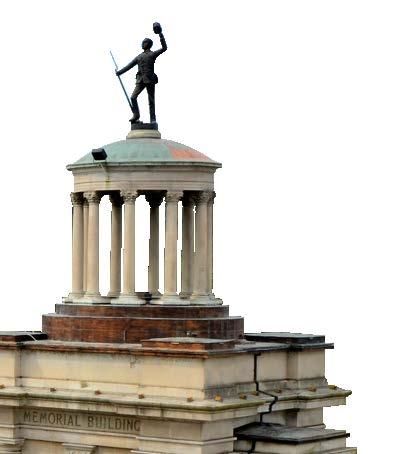



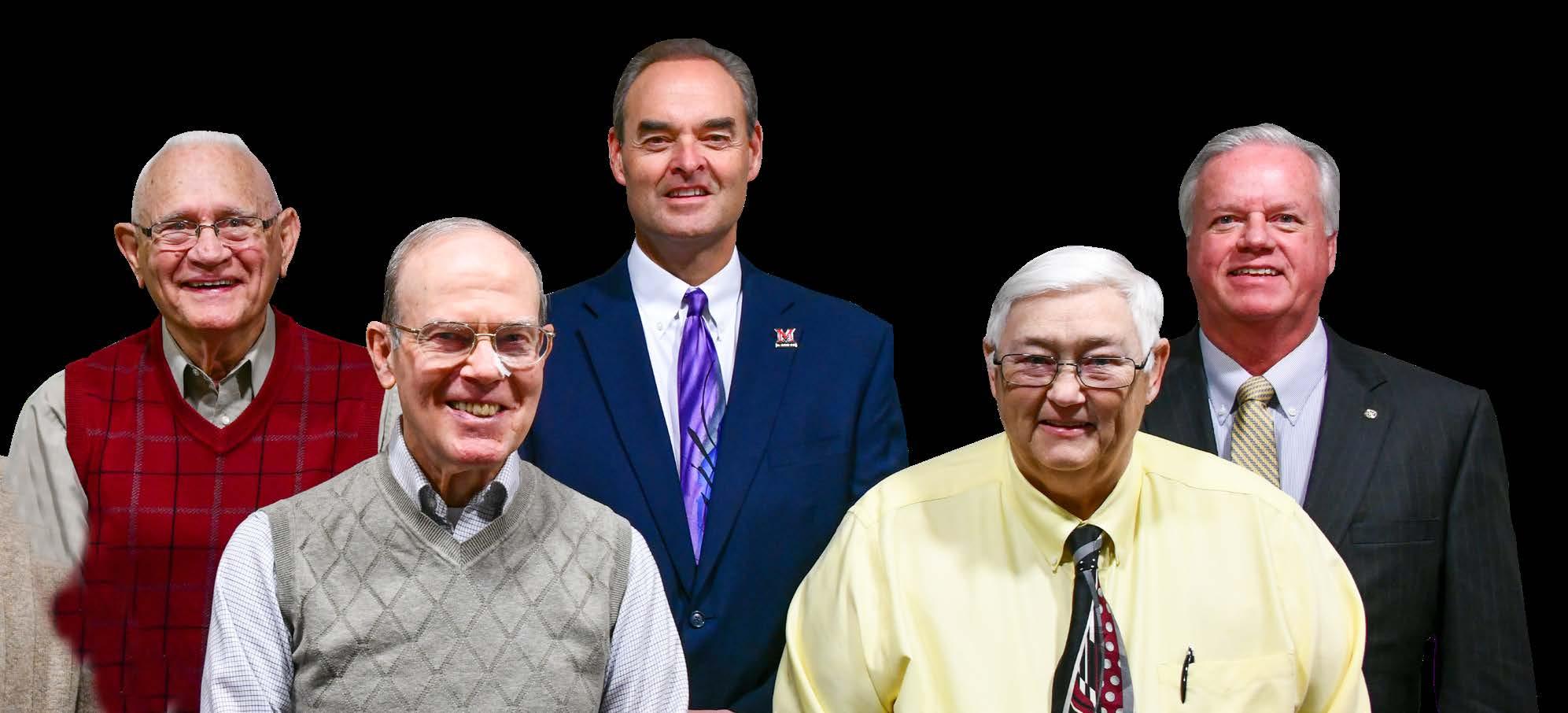
The City of Hamilton Public Utilities Commission (PUC) is charged with advising the City Council and administration on matters related to the City’s municipal utility operations. The PUC provides advice, opinions and recommendations to City Council and the administration on a number of topics, including:
• Contracts, agreements, trust indentures and other legal obligations pertaining to the utility systems
• Utility rates and charges for customers
• Delinquent utility account procedures and practices
• Employment of Directors for the various utility systems
• Adoption and implementation of long-range planning for the operation of the utility systems
• Reasonable expenditures to acquaint the public with the operations, programs and plans of the various utility systems and to encourage conservation of utilities
The Public Utilities Commission (PUC) is comprised of seven Commissioners, each nominated by the Mayor or a member of Hamilton City Council. The Commissioners, required to be “resident electors” of the City of Hamilton, serve in a volunteer capacity on the Commission. Commissioners serve terms coinciding with the Mayor or member of City Council that nominated them to the Commission. As part of the PUC, Commissioners are considered to be public officials and are an integral part of every project undertaken by Infrastructure.
 BOB CASSADY
GENE BELLER
CHRIS CONNELL DELBERT PRICE
DAVID STITSINGER BILL MERRITT
BOB CASSADY
GENE BELLER
CHRIS CONNELL DELBERT PRICE
DAVID STITSINGER BILL MERRITT

The Department of Infrastructure supports and enhances the life of our community by providing reliable, competitively-priced, and locally controlled utility service to our customer-owners. We deliver safe and reliable electric, natural gas, water, wastewater, and commercial broadband services at affordable rates with exceptional customer service. Integral parts of our mission are providing a safe and rewarding work environment, exceeding all regulatory compliance standards, maintaining the long-term financial strength of our utilities, supporting economic development, and promoting environmental stewardship.
In addition to providing utility services, the Department of Infrastructure supports the community by maintaining safe streets and stormwater systems.
The City of Hamilton is fortunate to own and operate all of our utilities, in fact, we are the only City in Ohio that does. On top of that, the Department of Infrastructure includes our Public Works and Engineering services that have been centralized in order to make the most of our infrastructure efforts.
We are a not-for-profit utility governed by locally elected officials, advised by appointed boards, and directed by our citizens. This local perspective focuses our efforts on the long-term stability and success of our systems, knowing an investment in our infrastructure today reaps benefits for our community for generations to come.

The City believes in investing in our systems and investing in our people. We are fortunate to have a variety of highly skilled professionals as part of our team. We directly employ safety professionals, operators, maintenance staff, electricians, line workers, customer service representatives, engineers, technicians, chemists, environmental scientists, and more. This diverse pool of talent means we are capable of performing more operations, maintenance and capital improvement work in house. When issues arise, our local teams are prepared to immediately react to resolve them, and then identify root causes to reduce issues in the future.
Central to our mission of empowering Hamilton through access to safe, clean and affordable infrastructure and utility services, our teams are committed to continuous improvement and finding innovative ways to better serve our community.
We are serious about keeping our focus on reliability and system stability. With Hamilton having been awarded the E.F. Scattergood System Achievement Award in 2022, these efforts were recently recognized by the American Public Power Association (APPA)
The Department of Infrastructure is excited as we look towards the future. In an ever changing world, the need for the essential services that we provide remains constant. We will remain adaptable and continuously evolve our systems to serve the needs of our community. We will continue to pursue excellence and service at the highest level.
My hope is that once you have had the opportunity to review this update that you are as proud as I am of the vast, award winning infrastructure we have in our community which makes the everyday possible.

Respectfully Submitted,
 Edwin Porter
Edwin Porter

We are the only city in the State of Ohio that owns and operates all four major utilities: electricity, natural gas, water, and wastewater. As a not-for-profit utility governed by locally elected officials, appointed boards, and citizen input, we are able to remain stable and focused on serving our community, rather than being influenced by investors. It also makes doing business here a breeze, with only one bill coming to you for all your utilities.
Our team is continuously searching for ways to build system redundancy and proactively improve our systems, helping us achieve the stellar reliability our customers enjoy today. They do this while keeping a close eye on the costs and benefits of our efforts allowing us to provide top service at a great value.
While reliability and stability are important, we are also committed to continuous improvement and finding new and innovative ways to better serve our community. In 2017, we merged the Utilities and Public Works departments to form the Department of Infrastructure, creating a stronger and more comprehensive service dedicated to meeting the needs of our community. We look forward to serving the City of Hamilton’s residents and businesses for many generations to come.
One of the highest honors from the American Public Power Association (APPA) highlighting community-owned utilities that have enhanced the prestige of public power through outstanding service to its customers.
APPA designation demonstrating high proficiency in providing long term reliable power in addition to receiving a Certificate of Excellence in Reliability across multiple years.
Awarded by the American Public Gas Association to utilities that demonstrate commitment to excellence in four areas: System Integrity, System Improvement, Employee Safety, and Workforce Development.
Best Water in the World Berkeley Springs Water Competition 2010 & 2015.
(In addition to many other water taste and quality accolades over the years.)
Issued by the National Institute for Automotive Service Excellence, this certificate shows our team’s commitment to quality repairs and service of the City’s fleet.


Infrastructure plays a critical role in economic and community development activities. Utility offerings, reliability, pricing and conditions have direct influence on a person’s or business’ ability to thrive. But keeping the lights on and water running is just the start. From each utility pole to pipe in the ground we look to make sure that
when you need them, your utilities are there for you. Additionally, helping you understand what to expect when it comes to utility costs is a priority of our Infrastructure Department. We are happy to work proactively with residential and commercial customers alike to make sure you know what to expect when your bill arrives.
Hamilton has long been a leader in renewable energy, focused on the development of environmentally conscious power supply for our system. As early as the 1840’s, hydro power generated from the Hamilton Hydraulic System was fueling manufacturing in Hamilton. Today, more than 50% of the city’s power is generated by renewable resources. Hamilton operates and maintains a majority stake in both the Meldahl and Greenup Hydroelectric Power Plants on the Ohio River and owns generation rights to a number of other carbon-free assets. These hydroelectric resources provide our customers a reliable source of energy and long term price stability.
For our every day customers the renewable energy certificates (RECs) associated with our hydroelectric plants are sold to the market
helping save on power costs. Once the RECs are sold, that energy is not considered to be “renewable”. While the value of those credits changes with the energy market, as of this writing the practice is saving our average customer more than 2% on electric costs.
For customers who want renewable energy there is our EcoSmart Choice program. Commercial and industrial customers can opt into the program, run through American Municipal Power, Inc. (AMP), that supports renewable energy development from a variety of sources, such as hydroelectric, landfill gas, solar and wind facilities. EcoSmart Choice allows Hamilton customers to add an allocation of their electricity usage to renewable energy certificates (RECs) to receive up to 100% green energy.
New Surface Lot Being Constructed - Near Maple and MLK Jr. Blvd.
Not only is Hamilton unique in that we have public utilities, we are also fortunate to have local talent managing them. Our crews do not have a territory that crosses multiple cities as is the case with many investor-owned utility companies. Our crews work exclusively in this city – their city –the one they know so well. Our teams are often nearby, able to respond quickly to issues when needed. Additionally our ‘local advantage’ goes even further with our team’s knowledge of our infrastructure, given that they are dealing with the same equipment they maintain everyday. With a wide variety of expertise available 24/7/365, we are in a uniquely powerful position to respond to almost any situation at any time, ensuring that our customers always receive the support they need when they need it. This enhances reliability and reduces downtime across the board.
On all fronts, Hamilton’s infrastructure is set up for the long term. Anticipated service life and long term operating costs are a top priority when planning projects. Annually we focus on efforts that ensure the longevity of our systems with programs like tree trimming and water valve exercising, (See pages 10 and 16)
On a system capacity front we have the ability to meet our electric, water, wastewater and gas needs for years to come.
Electric
Avg. Daily Load: 100 MW
Peak Generating Capacity: 173 MW
Water
Avg. Daily Use: 15 MG
Max Daily Production: 46M Gallons
Wastewater
Avg. Daily Flow: 8.5 MG
Designed System Capacity: 32M Gallons Per Day
Currently, Hamilton’s Electric system is the second largest municipally owned system in Ohio. It is also fully integrated, which means that the Hamilton Electric Department handles electric generation, local transmission and distribution of the power it creates. Hamilton’s power is created through a diverse portfolio of both thermal and hydroelectric generation facilities. When it comes to sustainablity we are well ahead of the curve with our landmark

• Number of Customers: 29,582
• Total Revenue (2021): $79.6M
investment in Meldahl, the largest run-of-theriver hydroelectric plant on the Ohio River. Additionally, Hamilton has an ownership interest in the Greenup facility (another run-of-the-river plant on the Ohio River), and the generation rights to a number of other carbon-free assets, including a stake in the Niagara hydroelectric power project near Niagara Falls.
• Top Customer (2021): CyrusOne Data Center
• Founded: 1893
GENERATING CAPACITY: 173,000 KW
PEAK DEMAND: 136,000 KW
POWER GENERATED FROM HYDRO: ~60%
NUMBER OF GENERATION ASSETS (POWER PLANTS): 8
Small incremental change is often critical to making lasting improvements to just about anything in life and Hamilton’s electric reliability is no exception. Around 2016 an effort was made to look for more proactive opportunities around our ongoing distribution infrastructure maintenance. About $2.5M has been invested annually into programs that have: assessed our infrastructure and surrounding vegetation, replaced utility poles annually nearing the end of their useful life and trimmed back vegetation around our electric infrastructure throughout the City. This continued investment has taken Hamilton’s already good reliability record and made it great! Thanks in no small part to these programs, today Hamilton is the proud holder of three prestigious national honors: The American Public Power Association’s E.F Scattergood Award, a Certificate of Excellence in Reliability, and the Reliable Public Power Provider (or RP3) Diamond designation.

New Substation 12 (HEP #2)
At the end of 2021 a new substation, HEP #2, supporting Hamilton Enterprise Park was completed. This $12M investment was an important milestone in future proofing our distribution infrastructure for years to come. The 90 MVA, 138kV/13.7kV substation provides additional distribution capacity, or enough power to support about 18,000 residential homes, to the most industry rich section of the city. HEP #2 also provides system redundancy with the help of HEP #1 substation in this area, which is critical to ensuring that electric service to industrial customers in Hamilton is as reliable as possible. Now that this new infrastructure is complete, HEP #1’s capacity can be used to support current and future customers, while improving redundancy and reliability for our customers.
“Tonight we turn a lever and press a button and behold, the heavens are ablaze with light!” proclaimed Nelson Williams, a lawyer, civic leader, and feature speaker of the Great Electric Light Celebration of 1895. The occasion was to mark the completion of the first municipal power plant on North 3rd Street.
The modern marvel of a facility featured a pair of arc lighting machines providing 120kW of electric power and three Corliss engines manufactured by Hamilton’s own Hooven, Owens, & Rentschler Company. Electricity was set to be a huge benefit for Hamilton residents, as it was expected to provide residential lighting at 40% the cost of gas and to be available 24/7. At the time, gas lighting was only available through a private company from twilight until midnight each day.
A parade, band concert and official program around the Butler County Courthouse kicked off the celebration that was accented with a 50-gun salute, ringing fire bells and fireworks. And, as promised, with the turn of a lever and a push of the button, the first 215 city street lights “set the heavens ablaze with light.”
Over the next 50 years, Hamilton’s electric generation grew in step with the growth of demand and soon the scale of our systems called for increased connection with the regional grid. Today, Hamilton meets our customer energy needs through a well diversified generation portfolio that includes rights to power and generation that we own and operate, located throughout the midwest. Hamilton relies on our in-city generation assets primarily to provide support on peak power usage days. Peak days now demand in excess of 1000 times more energy than the inaugural plant was capable of.
Hamilton is currently the largest municipal gas distribution operation in Ohio, serving approximately 23,500 customers located in the City and the immediate area through approximately 282 miles of pipe. Our full service system purchases natural gas from a supplier, arranges for its transport to one of our two system interconnections and delivers the gas to customer meters for resale to residential and general service (commercial and industrial) customers. Hamilton’s gas system also provides distribution delivery services to customers who have contracted independently with either the city or natural gas suppliers.
A little friendly competition not only helps make a game more interesting, but can also help keep prices stable. In Hamilton, our natural gas system can purchase gas through one of our two interstate pipeline connections. On the South side of the city we are supplied with gas from the Gulf of Mexico by a connection to Texas Gas and on the North side Texas Eastern draws gas supplied from both the gulf and northern Appalachian Mountains. This allows Hamilton to pick the best deal available between the networks of the two pipelines when negotiating long term gas contracts while maintaining the other as a backup.
• Number of Customers: 23,544
• Total Revenue (2021): $16M
• Top Customer (2021): Strawser Construction
• Founded: 1890
LARGEST MUNICIPAL GAS SYSTEM IN OHIO

ANNUAL INVESTMENT IN MAIN REPLACEMENT: $600,000+
MILES OF DISTRIBUTION
PIPES: 282
NUMBER OF INTERSTATE SUPPLY
PIPELINE CONNECTIONS: 2
Because of our long term focus on rate stability, Hamilton has had one of the lowest customer gas costs in Ohio for over a decade.
- Christine Carr | Acting Director of Business Services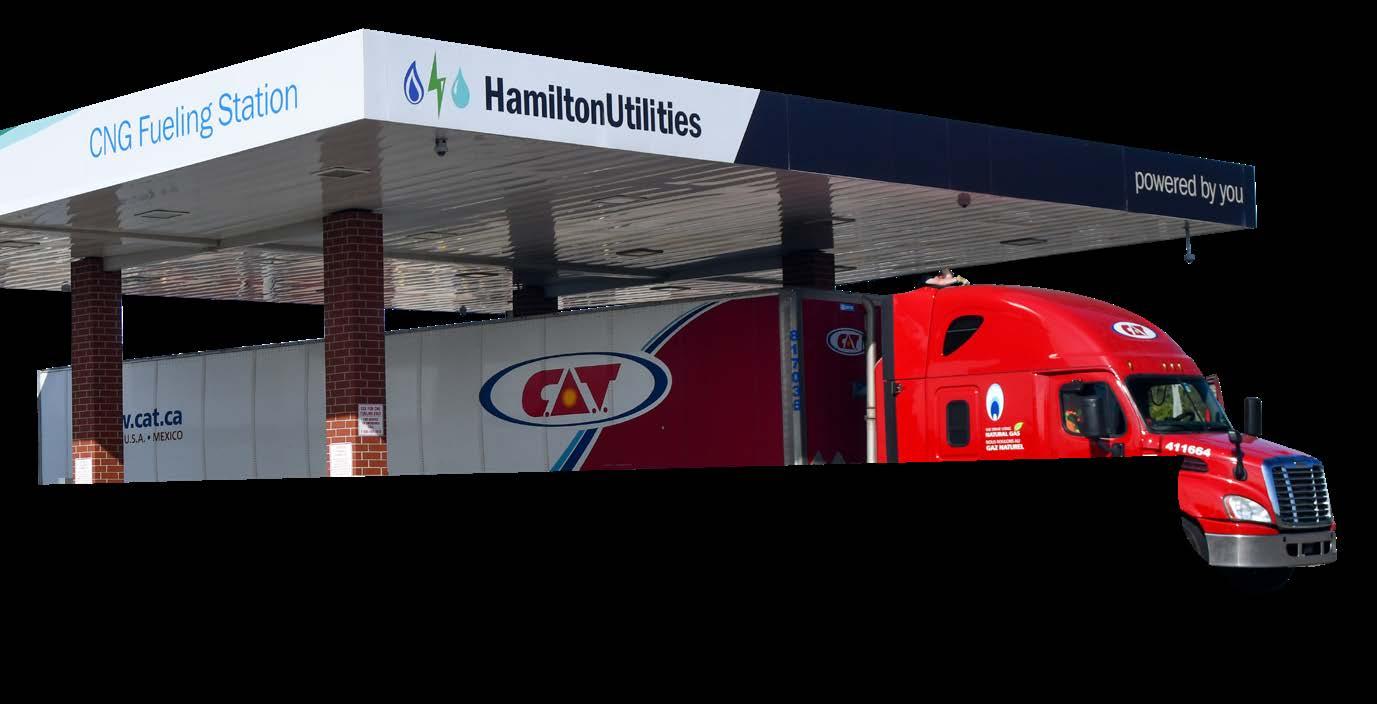
There are plenty of benefits to having a large municipal system that sells a significant amount of natural gas like being able to participate in the ‘municipal aggregation program’ which saves all of our customers about 30 cents per unit of gas used. Since this program was instituted, it has saved our customers more than $20 million total. Another benefit is having significant guaranteed buying power behind us when we negotiate long-term bulk purchase contracts - a practice that has proven very beneficial for our customers.
There are even more benefits in store through our second largest customer, the Hamilton Electric Department. The Electric Department runs two ‘Peak Demand’ natural gas power plants in the City when demand reaches its highest points throughout the year. While they only run for about 80 hours in a year, in that time become our 2nd largest natural gas customer. Their impact on our rates is critical. Combined, the plants provide about 44 megawatts of power locally that Hamilton does not have to receive from the grid. This effectively lowers our transmission and capacity costs, which are set annually by the amount of power we take from the grid on the grid’s highest use days each year. This allows us to sell a lot of gas and save on electric transmission and capacity costs, while selling the power we have outside of Hamilton at some of the highest prices of the year: a win, win, win for Hamilton Utility customers!
The City of Hamilton has one of the largest, most affordable and reliable municipal natural gas systems in the State of Ohio. However, getting there was not an easy journey. In 1855, Hamilton City Council granted a franchise to the Hamilton Gas Light and Coke Co., a private company that made artificial gas supplying only up to 60 city streetlights at the time.
After more than 30 years of customer complaints about rates and services provided by this company, a city-operated gas plant was proposed by city council and approved by Hamilton residents in 1888. The municipal gas works began operating in 1890, but closed soon after in 1905, leaving the city to rely on a private supplier once again.
Five years later, natural gas once again flowed into the city’s 48-mile system, however, numerous problems, including leaks, occurred throughout the next 16 years as the city and gas system experienced a period of rapid industrial and residential growth.
As the demand for natural gas increased during the 1920s, questions began to arise about whether municipal ownership of our gas operations was favorable or affordable for Hamilton residents. This led to a special election in February 1926 where Hamilton voters were asked to decide between a city gas operation or changing to a privately-owned one. Despite its problems and shortfalls, citizens voted in favor of keeping the municipal system. Hamilton continued to heavily invest in its gas system at a loss through the depression and as World War II was reaching its peak the system finally became financially solvent and stable - nearly 55 years after its founding.

Originally constructed in 2004 and 2005, Hamilton’s fiber infrastructure was built with the future in mind. The 50+ mile loop around town was built more robustly than what was required for the city’s various IT, phone services, and, importantly, utility Supervisory Control and Data Acquisition Systems (or SCADA for short). In time this led to the general lease of unused fiber capacity, or dark fiber, to a private company who then used it to provide broadband service to various Hamilton companies.
Internet availability, speeds, and access are an important factor for business growth. One-Hundred-Forty years into business, Hamilton’s Utilities are still looking to the
future. Seeing the true potential of the service, City Council approved a pilot program for municipal fiber in 2021 which started out with 9 customers. In 2022, with unified Council support, Hamilton’s newest utility was born. Today, Hamilton Fiber is offered by request to commercial and industrial customers within the city and is managed by staff of the Electric Department who were instrumental in its creation. The network boasts more than 70 miles of fiber infrastructure, a direct connection to the internet, and a unique 1-to-1 download to upload ratio. With a rapidly growing customer base and expanding network we cannot wait to see where this new service will take us in the future.
Also known as a true symmetrical connection, for every Mbps of download speed Hamilton’s fiber offers the same upload speed.
Hamilton’s fiber backbone has been laid in a 360 degree ring around the city. Meaning, if any part of the fiber backbone is compromised, service can be maintained in the opposite direction. This minimizes interruptions while repairs are made.
Just like all of our other utilities, we support our fiber customers and infrastructure in house with local professionals who take pride in their work and are in the area.

With more than 30 years of experience at the City of Hamilton, John Bui has a unique story of how he came to find his passion and started his professional career treating water. Learn more about Bui’s expertise on chlorine dioxide generation as a means of drinking water disinfectant and how this has contributed to Hamilton’s internationally award winning water.
John Bui, City of Hamilton’s Water Production Superintendent, started his career with the City of Hamilton in 1992 working in the Water and Wastewater Laboratory. But Bui says his journey to becoming a water operator began when he was 10-years-old.
While living in Vietnam, he would help his mom treat water that he would collect from a nearby river, carrying it home and putting it in a 55 gallon drum. When the drum was full, Bui’s mom would give him a large crystal to stir the water and then he would wait for the colloidal solids to settle to the bottom indicating that the water was ready for household use. In Bui’s freshman year of college, this water purification technique became the focus of a class project as he made the same crystal he used to treat water with his mom growing up. It was at this point that Bui says he fully believed it was his destiny to become a water professional.
Today, Bui has more than 30 years experience at the City of Hamilton, a Bachelor’s of Science in chemistry, a Class III Wastewater Operator License, and a Class III Water Supply License. Bui’s impressive background and expertise on chlorine dioxide generation as a means of drinking water disinfectant has made him a go-to resource on the topic for agencies, including the US EPA and other utilities nationwide.
The City of Hamilton is one of only two utilities in Ohio that use this type of treatment which is credited as one of the reasons Hamilton’s water is internationally award winning.

Q: Tell us something you’re proud of.
A: I am proud of my heritage and proud to say that I am an American. America is the land of opportunity. If you work hard, you can achieve your goals. The sky’s the limit. My mother gave me life, the Filipino people gave me a second chance to live and the United States raised me to be a productive member of our great nation.
Q: Tell us about your talents or hobbies. How did you get started?
A: I am kind of a handyman. I do a little bit of everything from home remodeling to fixing cars. I can perform electrical and plumbing work as well. I don’t easily give up on anything I encounter.
Q: Share a favorite memory.
A: Every year when we celebrate Jesus’s Birthday, I remember my Mom. She passed away on Christmas Day in Vietnam in 1995. I will never forget the teary phone call I received on Christmas Eve from my sister in Vietnam about my Mom.
Q: How would your friends describe you?
A: My friends would say I am a caring person, smart, personable and helpful.

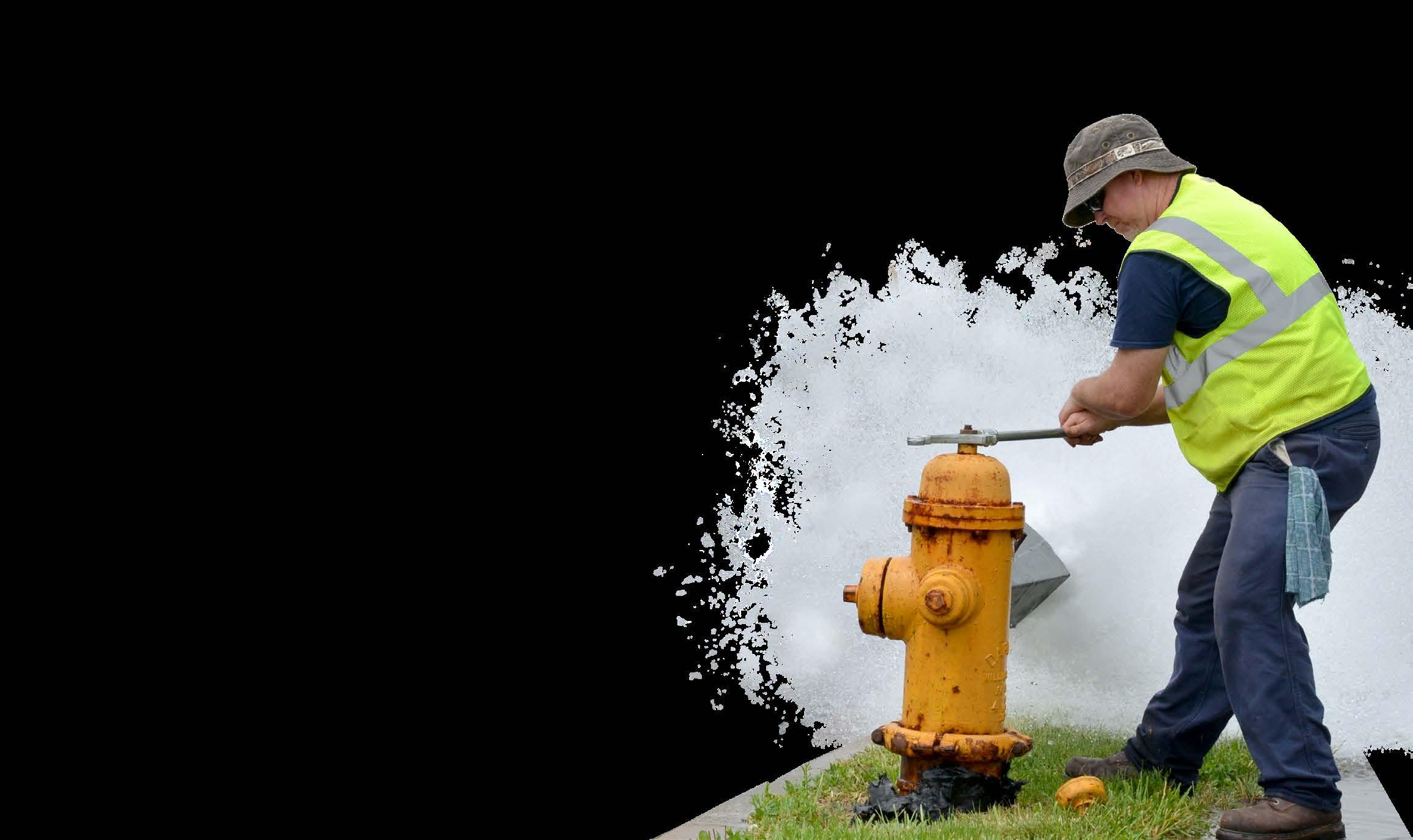
Hamilton’s water system is a full service system and is comprised of multiple assets including: two ground water well fields, the primary South Water Plant, the North Water Plant which primarily serves as backup and emergency redundancy, water storage tanks and raised storage tanks, and the distribution system at large. The system meets or exceeds all generally accepted water quality standards and has received multiple awards for water
quality and taste. Hamilton is also a proud member of the Hamilton to New Baltimore Groundwater Consortium which is a multi-jurisdictional collaboration charged with protecting the groundwater tapped by the cities of Hamilton, Fairfield and Cincinnati as well as the Southwestern Ohio Water Company, the Southwest Regional Water District, Butler County Water and Molson Coors.
• Number of Customers: 24,308
• Total Revenue (2021):
•
• Top Customer (2021): Butler County

It starts with raw water from the Great Miami Buried Valley Aquifer. The same, nearly inexhaustible, aquifer that supports the cities of Dayton, Miamisburg, Franklin, Middletown, Hamilton, Fairfield, Oxford, Trenton, New Miami and Cincinnati with as much as 300 million gallons of raw ground water a day. Then come some pretty standard steps like aeration, softening, and clarifying of the raw water. Finally, unlike more typical, and easier, chlorination processes, Hamilton uses chlorine dioxide gas as a disinfectant. It works because the gas remains in a solution when under pressure in our water system but then it evaporates out almost instantly as water leaves the faucet. The result is a high-quality, safe drinking water with almost no residual chlorine taste - literally an award-winning combination.
Thirty minutes of exercise a day is a good target for most people, but when it comes to the more than 320 miles of water distribution infrastructure in the city, a little twist once a year makes a huge difference in keeping it all in good working order. That twist comes in the form of our annual valve exercising and hydrant flushing programs. Valve exercising closes and opens each of the 5,000+ water main valves in the system which dislodges any naturally occurring buildup around the valve while ensuring that the valve is functioning properly. Hydrant flushing helps clear water mains of buildup and sediment and, as a bonus, exercises the hydrant’s valve at the same time. Both extend the usable life of these accessories, and any issues that are identified along the way are earmarked for repair. These practices ensure that our community has proper water pressure for fire protection and, should an issue occur, that it can be isolated to the fullest extent possible.
Before 1884, Hamilton residents drew water from private backyard wells and firefighters relied on a few large cisterns and hydraulic canals that had been built to supply water power to local industries. Over time, residents began to fear that the water wells in their yards were being contaminated by sewage and cases of typhoid were cited as circumstantial evidence. Soon after, an investigation reported that water samples from the Great Miami River were safer to drink than the water taken from backyard wells and as additional problems began to surface from our community’s water public pressure for a municipal water system mounted.
August 28, 1882, Hamilton voters gave official approval for the creation of a city water system. The vote was 1,405 in favor (81.3 percent) and 323 against.
The first municipal water system reservoir was located on Wilson Hill located between Millikin Street and Washington Boulevard. The six-million gallon reservoir sat 221 feet above High Street at the courthouse and 248 feet above the Great Miami River at low water, providing more than 90 psi of water pressure to most of Hamilton’s historic footprint. This original reservoir, while now modernized, is still part of the Hamilton water system today.
To complete the water system, 20 supply wells were dug and two large mains were built across the river.
The first water was pumped through city mains and to 300 hydrants across the city in July of 1884. By 1885, the city water system spanned 37-miles, had a pumping capacity of 300,000 gallons per day and served 2,604 customers.

About the Wastewater Department
Hamilton’s wastewater systems include over 257 miles of sewer lines and our wastewater reclamation facility is able to treat 32 million gallons per day. Our wastewater treatment facilities include our primary sludge plant and a sewer interceptor complete with a secondary
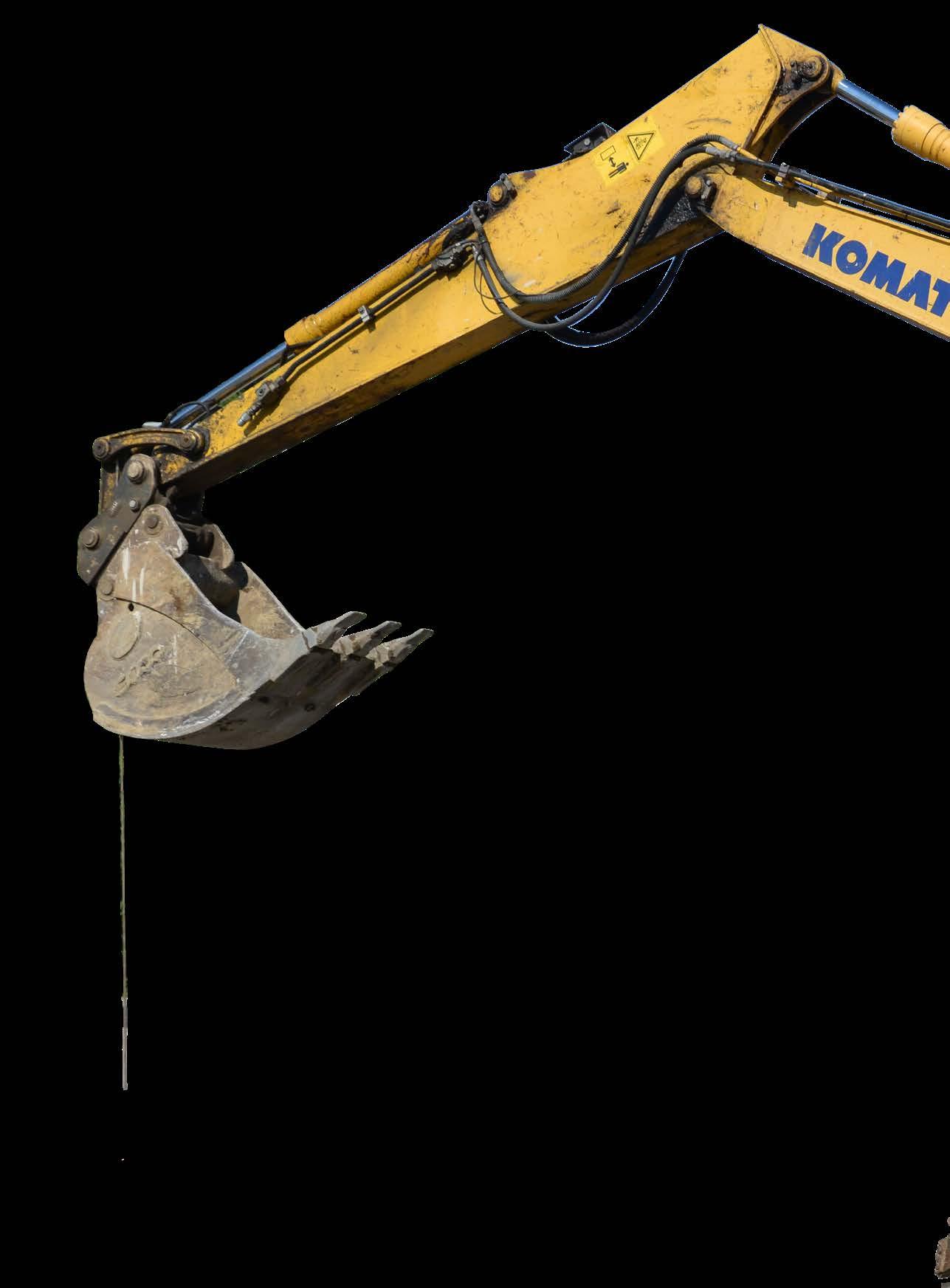
treatment process to handle wet weather flows in excess of 32 million gallons a day. The City’s current treatment demands are well below this capacity allowing for new users to connect to the system without a treatment plant expansion.
• Number of Customers: 22,997
• Total Revenue (2021): $12.6M
• Miles of Collection pipes: 253
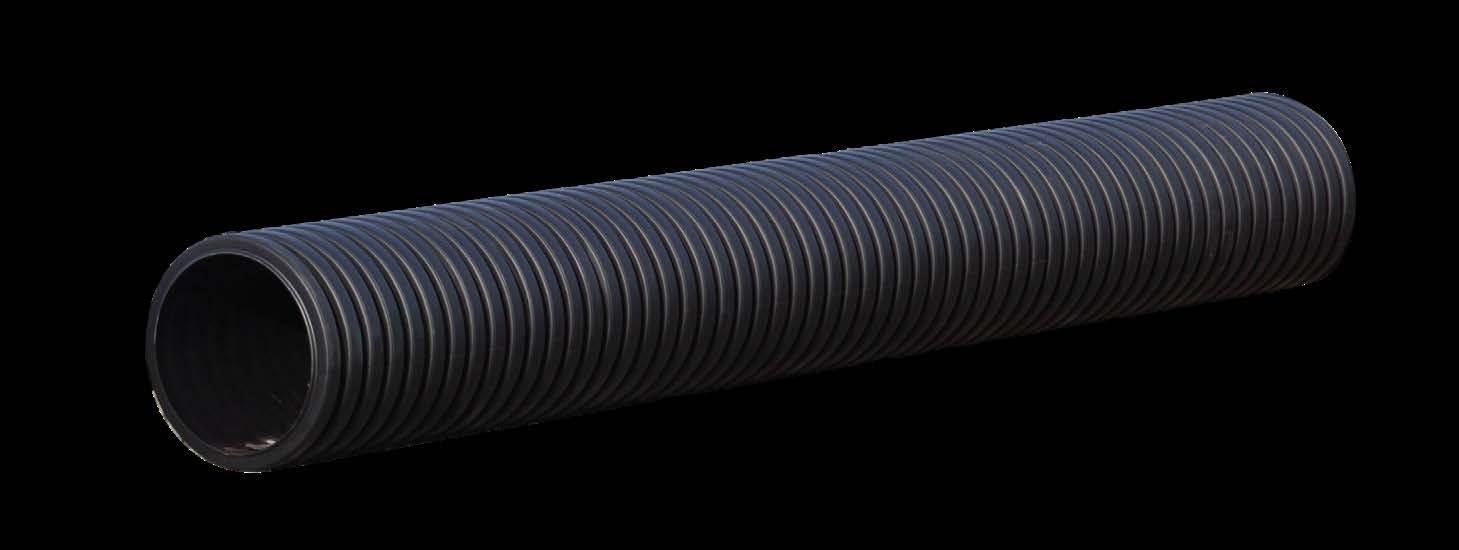
AVERAGE DAILY FLOW: 7.7 MILLION GALLONS A DAY
• Top Customer (2021): Synergy Flavors
• Founded: 1959
DESIGNED SYSTEM CAPACITY: 32 MILLION GALLONS A DAY
WET WEATHER CAPACITY: 62 MILLION GALLONS A DAY
LARGEST COLLECTION PIPE: 5 FEET WIDE
POUNDS OF BIOSOLIDS GIVEN TO LOCAL FARMERS:
One of the biggest challenges for a wastewater treatment facility is operating during wet weather when inflows from the system increase substantially. This extra water flow generally comes from legacy storm water connections into the system and the pressure of groundwater leaching into aging, but not failing, sanitary sewer pipes during rain events. One way we are helping fight stormwater infiltration is by proactively lining our sanitary sewer pipes. The process inflates a lining which expands and fills the sewer pipes which creates a watertight barrier and provides additional strength to the pipe. The relatively inexpensive enhancement to our existing pipe adds years of life to treated pipes without any digging needed! About 12,600 feet of sewer pipes are lined each year.
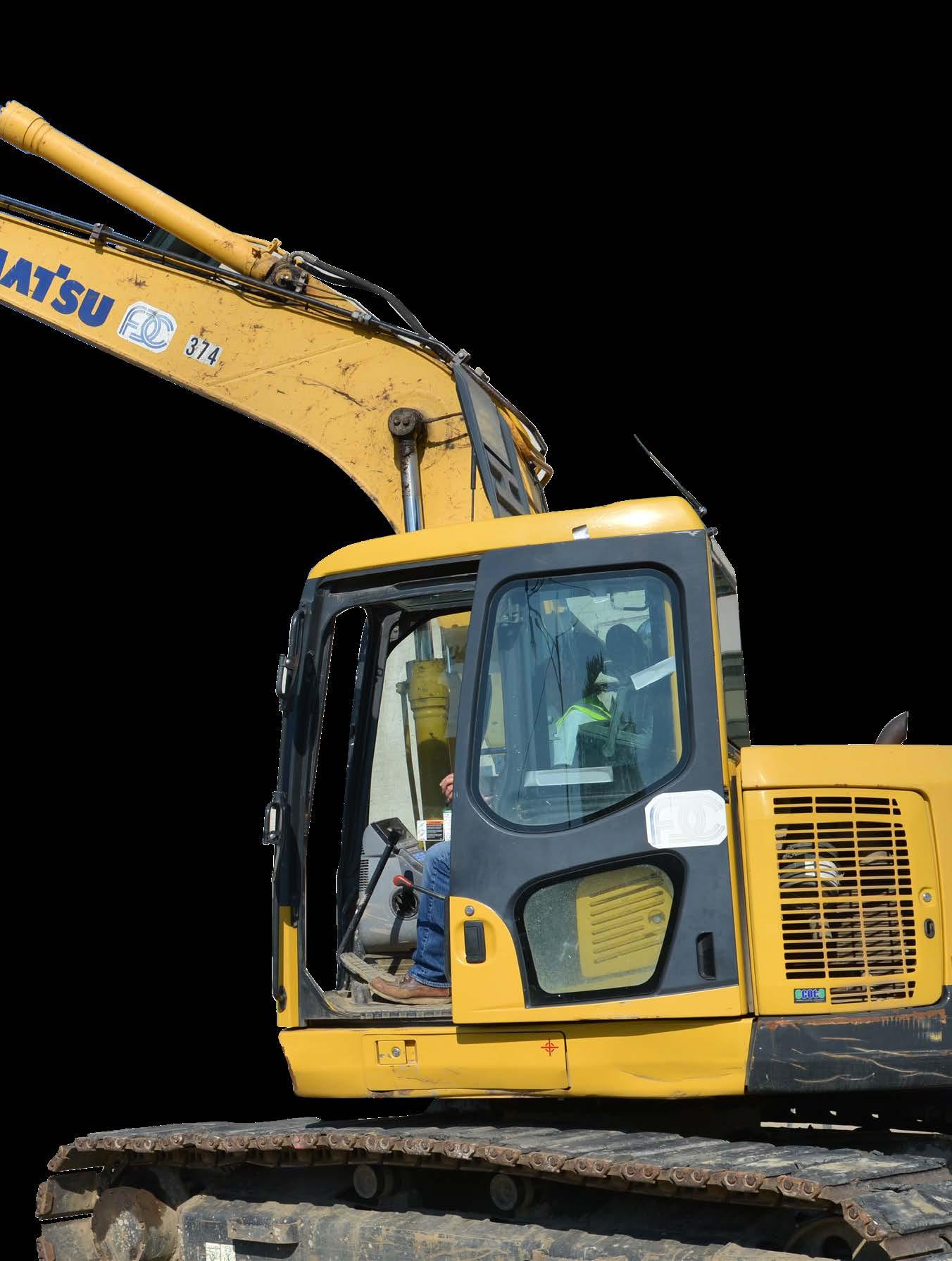
Comprehensive sewer systems were being built throughout Europe and the United States in the mid-1880s. These initial sewage systems consisted of diverting wastewater to farms, where the wastewater helped restore nutrients to the soil. Population growth resulted in larger volumes of wastewater to the point that the farmland method was no longer effective and thus began the development of modern biological treatment systems. These systems began to be slowly introduced across the country as needed and, in 1972, Congress passed the Clean Water Act making secondary treatment a requirement for all wastewater treatment plants in the US.
The City of Hamilton’s Wastewater System began with a sludge plant that was placed into service in 1959 and in 1978 the system expanded to provide complete treatment services to the community. Wastewater customer classes include residential, commercial, industrial and large contract customers totaling approximately 23,000 customers in all today. The Wastewater System serves the entire City and certain adjacent areas and accounts for 99% of the wastewater treatment services within the corporate limits of the City.
The Wastewater System has grown substantially since 1959 and currently consists of an expanded wastewater treatment plant (Water Reclamation Facility), located on the banks of the Great Miami River. In 2002, an expansion of the treatment facilities was completed. Today, in a nod to the origin of sewage treatment, Hamilton’s reclamation facility still provides more than three million pounds of reclaimed biosolids as fertilizer for local farms.
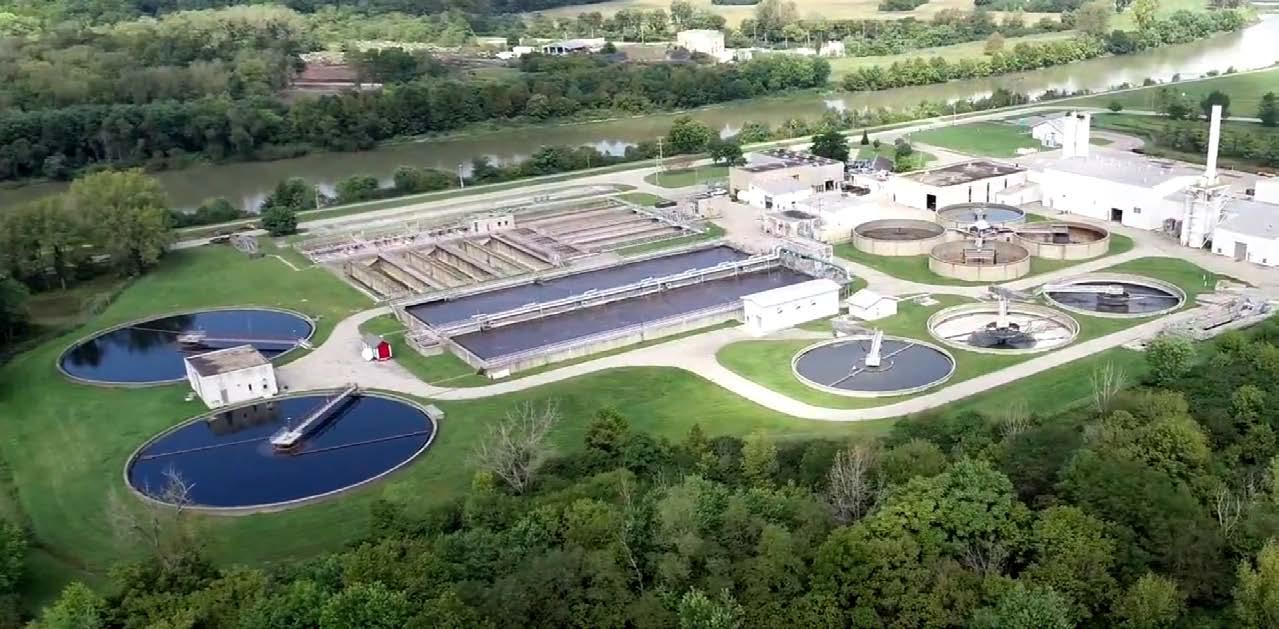
Originally started in 2015, the Key Accounts Program set out to intentionally touch base with the 25 top utility users in the City of Hamilton to better understand our customer’s operations and needs. Today, the program represents even more as it has helped create
a personal connection with representatives of each of these account holders, provided valuable insight from our commercial and industrial customers and has even expanded past those original 25 customers.
Going into a Key Accounts meeting, our team reviews the last 12 to 36 months of utility usage looking for general usage trends and for any irregularities from prior years. This data is discussed with the customer and in some cases even leads to insights on potential opportunities for
increased efficiencies for the customer. When appropriate, our team also prepares forward looking estimates of the customers utility costs to help them better understand what to expect over the next year.
While not for everyone, programs like Budget Billing (available for most customers) and the Peak Shaving Program (available for select commercial/industrial customers)
have benefits that some customers may not be aware of. Representatives talk through whether these programs make sense for their customers and their individual operations.
Another advantage of being a community owned utility is that Key Accounts meetings can take a moment to zoom out and talk about other projects and events that may impact our customer. This might include upcoming road work, special events or even potential future development projects in the area of your business.
If you are interested in being a participant in the key accounts program or want a review of your business’s utility usage do not hesitate to reach out to our customer service department.
Email: KeyAccounts@hamilton-oh.gov







Joy is a Civil Engineer who brings more than 35 years of experience to our city team! Learn more about Joy, her love of quilting, her dog ‘Copper,’ and her favorite music to listen to all year round.

Joy started her career with the City of Hamilton in December of 2012. She studied Civil Engineering at Ohio Northern University, brings more than 35 years of experience to our team, and holds a Professional Engineer (P.E.) certification. Rodenburgh supervises a team of three engineers who prepare construction plans and perform construction administration for the water distribution system, sanitary sewer collection system and the natural gas distribution system projects. Additionally, she is responsible for overseeing plans that are submitted through the Building and Planning Departments and assisting customers, engineers and developers with utility requests.
Q: What kind of music do you like? What do you like most about it?
A: I like a lot of different music, but my favorite is Christmas music. I like it because it is uplifting, cheery, soothing and there couldn’t be a better message. If you visit my office in the late summer or early fall, chances are you will hear Christmas music playing.
Q: Tell us about your favorite furry friend.
A: I have had a lot of favorite furry friends, but I am partial to Boston Terriers. I currently have a red and white Boston Terrier, Copper. He is our fourth Boston.
Q: Are you a morning person or a night owl?
A: I am a morning person. I am most rested at the beginning of the day.

Q: What’s your favorite season?
A: Fall is my favorite season. The heat and humidity of the summer are gone. Spring is nice, but the weather is too unpredictable. I like the fall colors and the cooler evenings.
Q: Would you consider yourself an introvert or an extrovert?
A: I’m an introvert. I don’t like to be the center of attention. I am quiet. I enjoy doing the “behind the scenes” work.

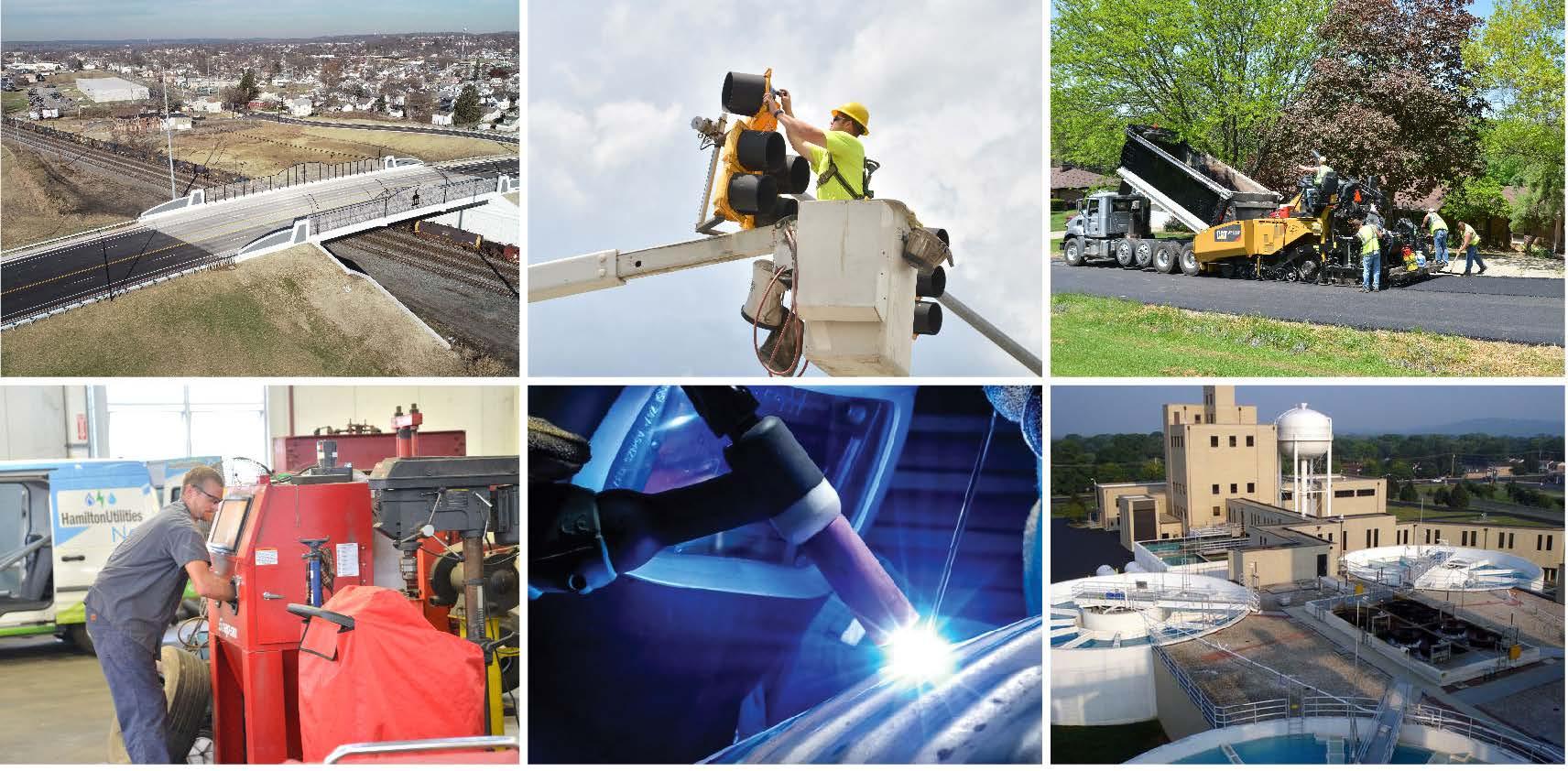

The Engineering Department serves the essential role of managing capital projects for streets, bridges, gas, water, sanitary, storm, and managing Hamilton’s traffic control system. On the engineering side, this includes engineering investigation, evaluation, planning, design, construction administration, and inspection of projects. On the traffic control side, it includes maintenance of all signage and traffic signals within the city, providing traffic control support
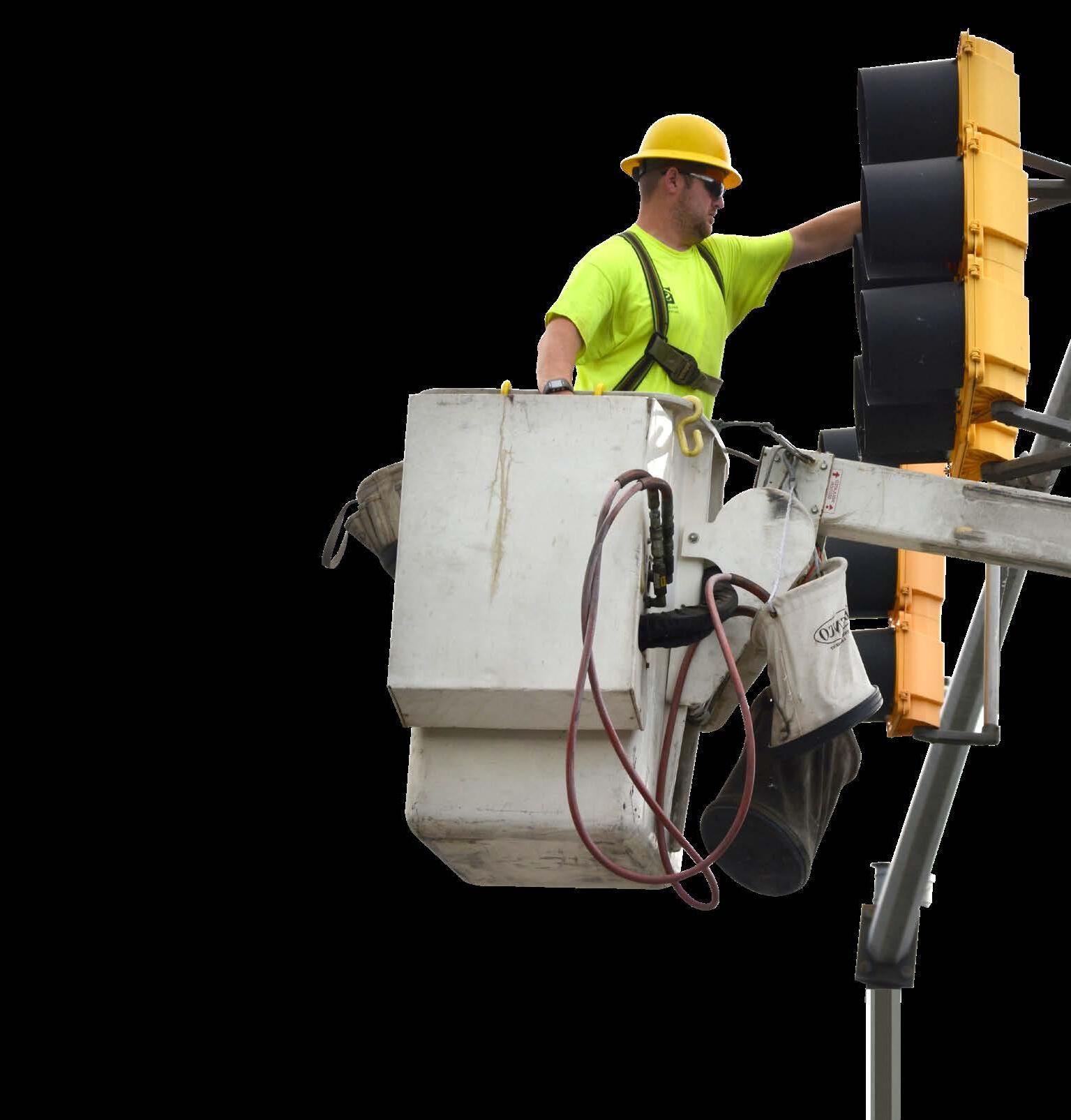
for special events and other in-street projects being done by other city teams, as well as operation and enforcement of public parking. Additionally, as part of its role in planning projects, Engineering provides support and leadership in applying for relevant grants, low-interest loans, and zero-interest loans for projects to minimize costs to our citizens.
• Number of Projects with Engineering Oversight: 10
• Amount of grant funding secured for projects (2022): $2.86M
• Total Value of Projects Awarded (2022):
TRAFFIC LIGHTS MANAGED:
• Number of Special Event Road Closures (2022): 99
INSPECTIONS PERFORMED:
ROAD CLOSURES PERFORMED FOR INFRASTRUCTURE DIVISIONS:

It’s easy to point out the visual impact of street trees or putting utility pipes underground along a primary corridor, but making a corridor function as a whole is a challenge that takes years of intentional, incremental investments. Since 2012, Hamilton has been focused on improving our primary Main and High Street corridors by systematically addressing problematic intersections and making various other improvements spanning between Erie Boulevard (State Route 4) and Cereal/Haldimand Avenues Intersection. These improvements not only helped traffic flow,
but have also improved safety for motorists, cyclists, and pedestrians. Thanks to significant grant support, more than $28.1 million in improvements has been invested along High Street, Main Street, and B Street over the last ten years. Over the next few years, Engineering will focus on Tylersville Road which recently benefited from the completion of the Five Points roundabout. Additionally, work continues on North Hamilton Crossing which looks to add another east-west connection that will avoid rail crossings and cross the Great Miami River.
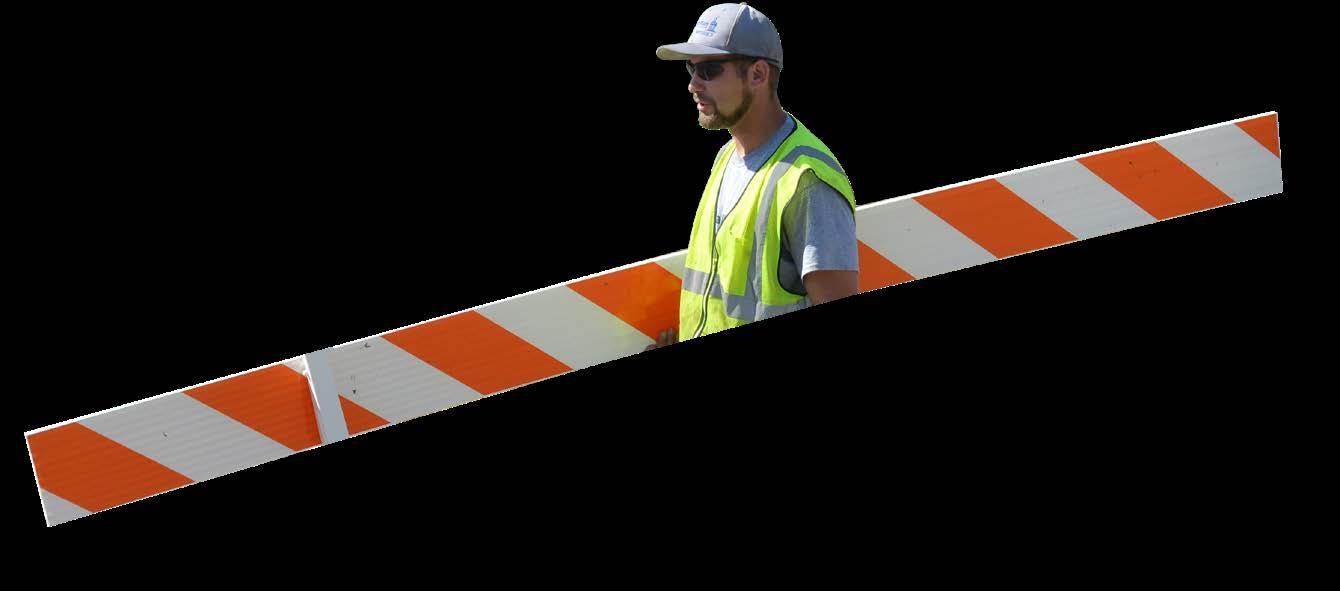
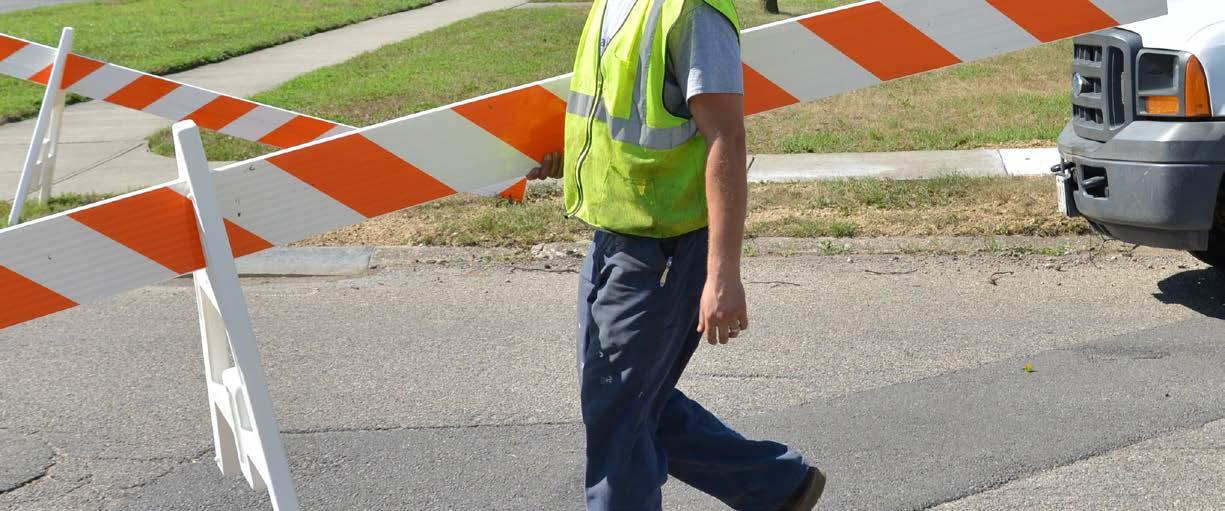
By the end of 2023, all of Hamilton’s signalized intersections will be updated to a new Centralized Traffic Signal System. The biggest advantage of this $6.0 million project comes in the form of having smarter traffic signals and connection to a central traffic controller. This allows for rich, ongoing data collection related to traffic flows in the city, and gives our team the ability to update signal programs without needing to physically go to each intersection. Additionally, the new system will be capable of making automatic adjustments to signal timing along key corridors in real time as traffic conditions change, as well as allow for emergency vehicle preemption, and provide automatic text message notification of potential system issues to operations staff. Once completed, each intersection will not only have new state of the art signal hardware, camera traffic detection, control hardware, battery backup, and fiber optic connectivity, but also new ADA accessible pedestrian sidewalk ramps. To top it all off, $4.6MM of the project was supported directly through the Ohio Department of Transportation (ODOT).
Hamilton is fortunate to count more than 23 engineers among our ranks with a number of different technical disciplines. Seven of our engineers are professionally licensed in the State of Ohio, meaning they continue to meet the rigorous requirements which demonstrate they are qualified to be in charge of public engineering projects. Our team of professionals follow projects from start to finish and evaluate and solve problems as they arise. Each brings a unique set of engineering skills and experience to the table to create an interdisciplinary work environment that focuses on the result of an infrastructure improvement rather than the scope of a project.
The City of Hamilton’s Public Works Department is responsible for maintaining and improving the infrastructure and public spaces within the city. The department’s tireless work ethic and professionalism has been crucial in ensuring that the city is a safe, clean and functional place to live and work. They perform a wide range of tasks and services with efficiency and expertise to
maintain the city’s public spaces, repair streets and ensure reliable water, storm, and gas systems.
The Public Works Department is divided into several divisions, each with its own specific responsibilities. These include: Field Services, Fleet Maintenance, Gas & Water and Streets & Sewers.


• Miles of Streets Maintained: 250
• Preventative maintenance services performed annually: 500+
• Potholes filled in a year: ~13,000
• Total number of fleet assets: 700+
MILES OF SANITARY SEWER CLEANED AND TELEVISED: 25.2
TONS OF SALT USED IN SNOW REMOVAL OPERATIONS:
TONS OF MATERIAL PICKED UP WHILE STREET SWEEPING: 900+
ASPHALT REPAIRS TO STREETS AND ALLEYS PERFORMED IN TONS:

The Public Works Department is on a mission to keep your city’s roads and streets in top condition. With our skilled pavement maintenance crew on the case, patching potholes and sealing cracks has never been more efficient. With more than 250 miles of roads in the city, they’ve got their work cut out for them. Just last year, the Public Works Department filled 13,000 potholes. In 2022 the average pothole request from our MyHamilton
(311) resident portal was addressed in about a week. Additionally, with the help of a new paving machine they are now performing street repairs. This has helped our team be able to address more urgent issues outside of our annual paving program which is planned years in advance. They’re paving the way for a smoother, more enjoyable ride for all of Hamilton’s road users.
The Public Works Department is dedicated to keeping our roads and streets safe and drivable during the winter months. With the help of the City’s snow informer app, you can receive real-time updates on which streets have been treated recently and how long it has been since a street was last treated. Additionally, the app includes useful information on how street treatment is prioritized and helpful snow event FAQs. Use the snow informer app to check road conditions next time before
The City of Hamilton has implemented a new method to reinforce valve boxes and manholes in newly paved streets to help make them and the newly paved street last longer. The tool, called ‘Mr. Manhole,’ is addressing a longstanding issue of faster degradation of asphalt near in-street-structures by adding reinforcing concrete around them. With more than 9,300 manholes in the city, it’s no small feat to keep them in top condition. Thanks to the use of concrete circular frames, the city is able to improve the overall condition of the streets and protect them from maintenance activities like snow plowing. Mr. Manhole is paving the way for longer-lasting,
 Snow Informer
Snow Informer
SPECIAL THANKS:
The late Jim Blount for historical reference materials found in the Lane Public Library’s Historical Collection.
LemonGrenade Creative for Design Development